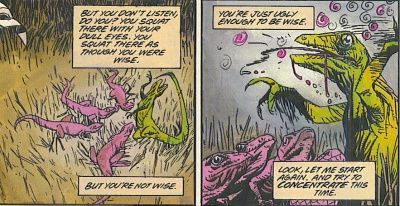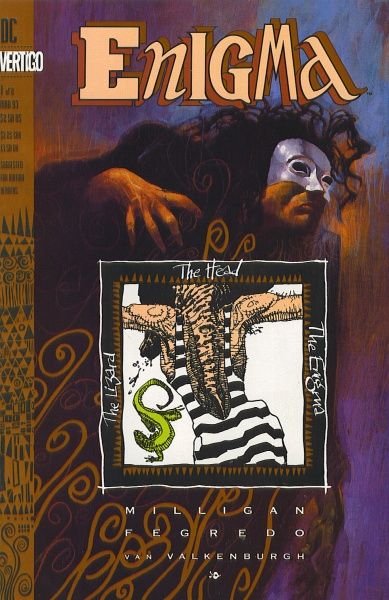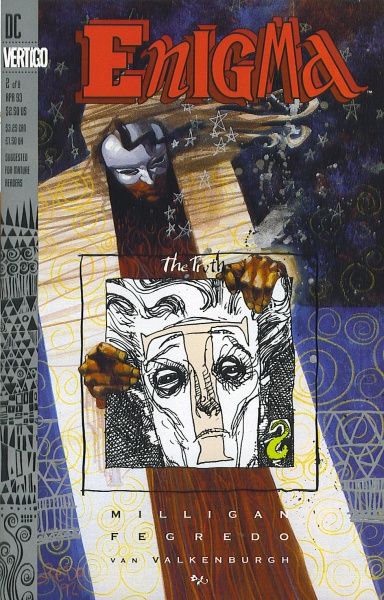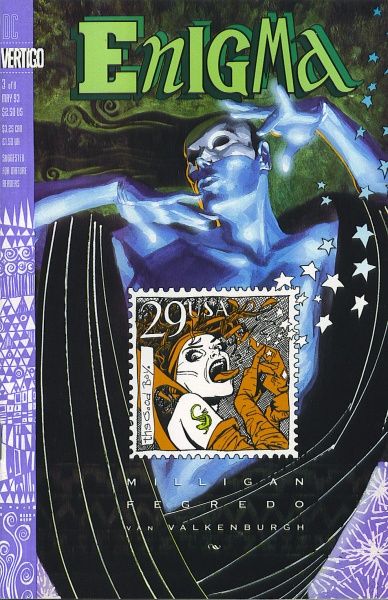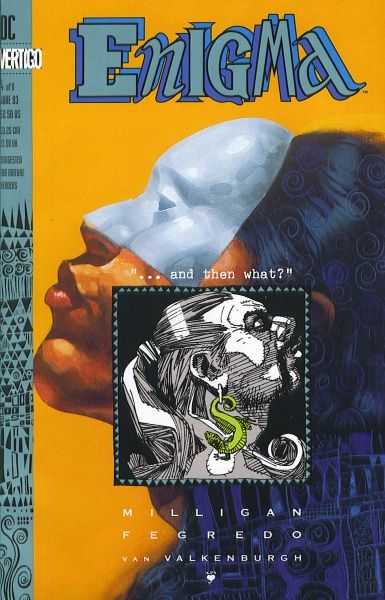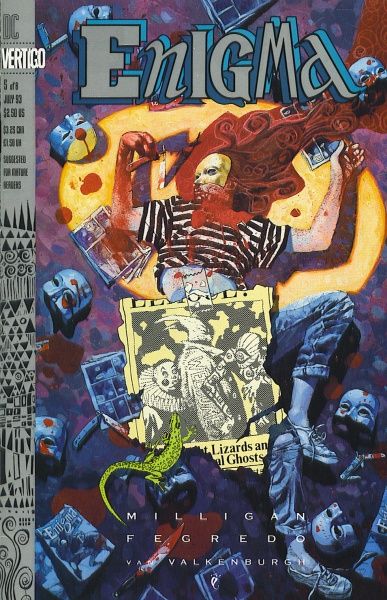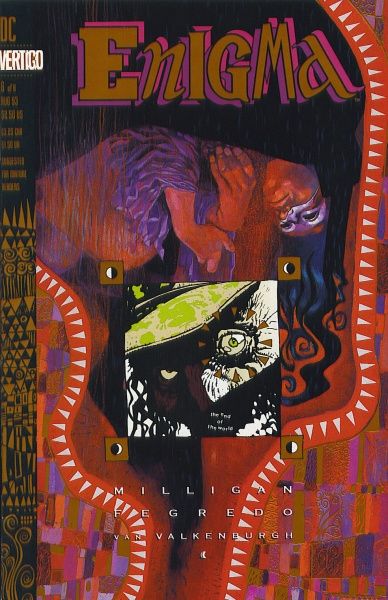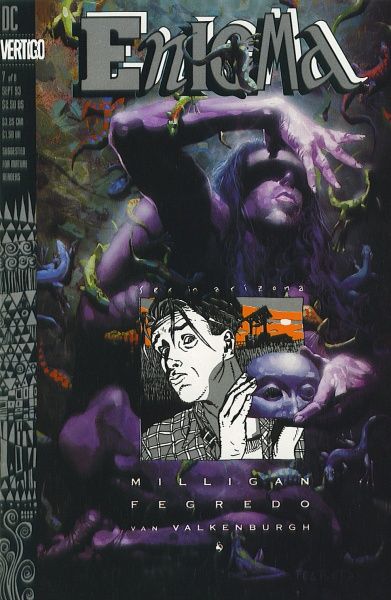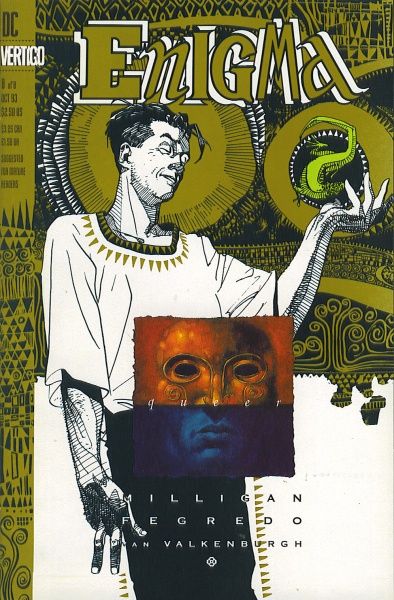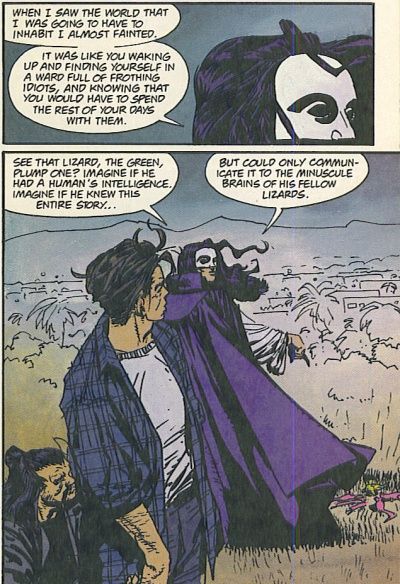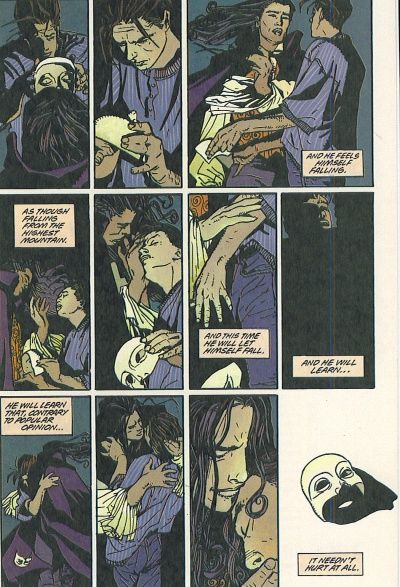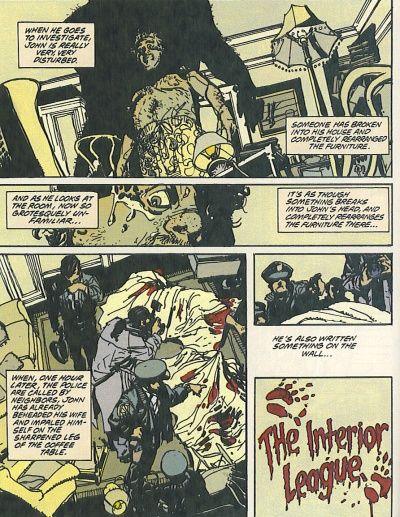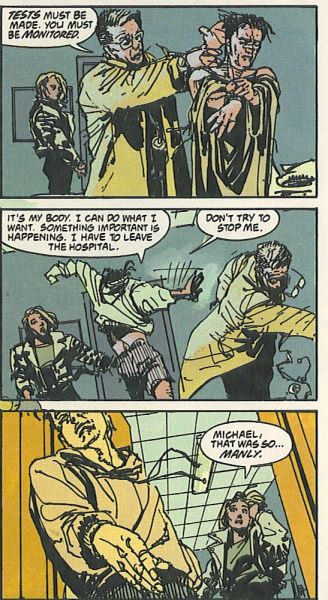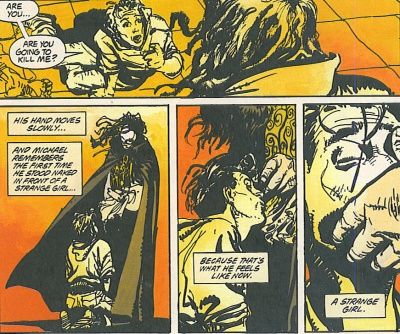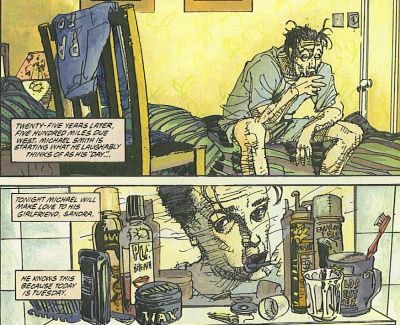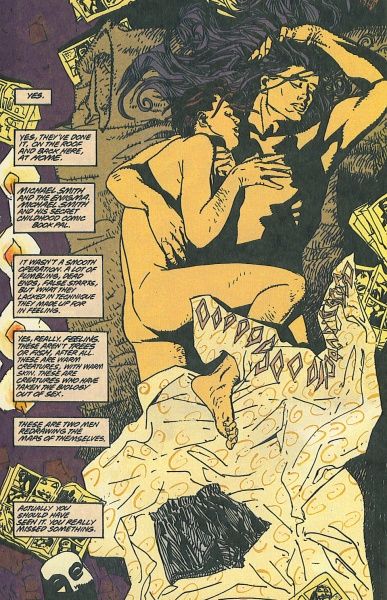Big-time SPOILERS in this post! I apologize for it, but it needs to be done!
Enigma by Peter Milligan (writer)and Duncan Fegredo (artist).
DC/Vertigo, 8 issues (#1-8), cover dated March-October 1993.
Peter Milligan has always been interested (some might say obsessed) with two grand themes: identity and sexuality. His best comics (Shade, the Changing Man; The Minx; Human Target; X-Force/X-Statix; even his brief run on Detective) deal with these themesin varying degrees of depth, butin Enigma more than most of his otherwork, these two themes are linkedvery closely.Milligan's ability tocreate characters who seemabsurd on the surface butturn out to be very human is one of the hallmarks of his writing, and in this series, he reachesfor great heights and gives us a disturbing yet uplifting story aboutdiscovering who we are. Milligan examines some toughideas in the book, including the how conscious we are of ourselves, how we choose to believe in things that might not be true because they're comforting, andhow we can become something more than we are.
The various themes are present throughout, but they really crystallize near the end, when we learn that, in fact, our narrator is a lizard. The Enigma, who is not really a superhero at all, gives a lizard human consciousness, and the lizard attempts to tell his fellow lizards the entire story, but they simply don't understand because, well, they're lizards. This is a fascinating device, because it leads us back through the story that is ending, and we come to new understanding about the Enigma and his place in the world, as well as Michael Smith's, as well as ours. Michael, the nominal hero of the book, has gone through a transformative experience, and he, like the Enigma, can't explain what he has gone through to his fellow humans. He is like the lizard with a human consciousness trying to explain to other lizards who are just lizards. He has been changed (in a passive sense - the change might have come from an external source), but he has also grown. Therefore, he can become something different, just like we all have to.
The idea behind the plot is that we are all hiding something, something enigmatic, and only by bringing that to light and examining it can we own it and grow. Michael is hiding the fact that he's gay. His sexual awakening is crucial to the story, and Milligan tells it in a fascinating manner. At first, Michael is in the closet, but his sex life with his girlfriend is predictable and boring. He meets Titus Bird, the writer of the old Enigma comic book, with whom he tries to discover the secret of the Enigma. Titus is gay, and at one point makes a pass at Michael, who violently rejects him. Titus is abject in his apology, and the scene earned the enmity of some letter-writers, even though it's quite obvious that Michael is sublimating. Later we learn that the Enigma made Michael gay, which is an odd twist, and when he offers to change Michael back, Michael tells him no. This feels problematic, as it implies that someone can change their mind about their sexual orientation, but the interesting thing is that Milligan leaves it very unclear about when the Enigma exactly changed Michael. It's vague if the Enigma really did anything to make Michael "different" or if Michael came to the realization himself. Of course, Michael and the Enigma become lovers, which makes the story even more problematic - the Enigma is supposed to be a fictional character come to life. Michael is learning how to live in his new skin. He has shed his old life and become something different, and his romance with the Enigma leads him to unexpected places. The book has been, all along, about discovery and rebirth, and Michael has to go through the birth pains. Far more important than Michael's orientation is his newfound capacity for love - the Enigma knows nothing about social mores or "orientation," and therefore can't be called "gay" or "straight," and Michael doesn't love him because he's gay, he loves the Enigma because this superhero offers the chance to be something different, to break away from the staid life he has known and experience true emotion. Milligan manages to make a nice statement on how people become what they are with the Enigma, who grew up with absolutely no social influence one way or the other. He simply is, and Michael falls in love with that dynamism. The Enigma is dangerous, too, because of his lack of social restraint, but that danger is also attractive to someone like Michael.
The Enigma, who remains somewhat of a mystery throughout the book, is more of a mirror in which we can see our world reflected than a real character. He shows us the ugliness of the world and the possibility of it. When he was a baby on a farm in Arizona, he did something to his father's face - we never learn what. His mother dropped him down a well and killed his father because what he did drove her insane. In the well, he survived and thrived, until one day when the new owner of the farm discovers that he's down there. For the Enigma, it was as if the world ended, because for him, that's what happened. His entire existence had been defined by a set of rules, and he suddenly realized they were wrong. It's not surprising that he too is insane, like his mother, but his insanity becomes a creative force when he realizes he has the power to shape reality. He finds Michael's old house, which had been buried in an earthquake, finds his old comic books, and fashions his world after what he reads there, with himself in the hero's role. But what he does with his power shows us that reality is malleable and insincere, and when, as the Enigma, he creates "villains" from the old comic book, they strip away the veneer of rational thought that exists in the world. The villains - the Head, the Truth, Envelope Girl, and the Interior League - show the people of the world the lies on which they have built their lives. The Interior League, for instance, sneaks into houses at night and rearranges the furniture in such a way as to drive the occupants mad. Milligan is making a sly point about how superficiality rules our lives, and because the Enigma created the League, he's revealing through them his contempt for the "normal." Michael, who is part of this normality, must overcome that, and because he does, he is able to confront the Enigma and survive. The Enigma is not in the book as a real character - he's in the book to simply show the other characters what they have been hiding. Only by standing up to the secrets and enigmas of ourselves will we be able to be happy. Those who don't spiral into madness.
Tied into the idea of identity and discovering who you are is the idea of belief and how it shapes our world. The Enigma is the model for this kind of thinking, as his beliefs about the world literally shape reality. He has nothing on which to model his world, so he uses Titus Bird's old comics as holy texts. Milligan is taking a shot at our own holy texts and the belief systems we base on them - who knows what future archaeologists will glean from the remnants we leave behind, so who knows what people in the past were really thinking when they came up with so-called holy texts? Titus Bird, as the author of these new holy texts, even becomes a figure of worship, by lost souls called the Enigmatics, who chase him down hoping for wisdom to spill from his lips. Our lizard narrators demeans these worshippers, asking "Did these apes lose most of their brains when they lost most of their hair?" and pointing out that although they can't wait to leave their parents, they just find new ones once they do. The Enigmatics play a small but crucial role in the proceedings, but it's interesting that the Enigma inspires a brand-new cult to spring up around him, and this belief of the Enigmatics changes reality just a bit. Michael's belief system, of course, undergoes the most radical change. His beliefs about who he is are completely upended, and his reality changes accordingly. In the beginning, he believes that he is a heterosexual male with a boring sex life - he and his girlfriend, Sandra, have sex only on Tuesday nights (why Tuesday?). Once he encounters the Enigma, his belief system changes and he starts to remake his reality. He is no longer a rather pathetic straight man, he is a dynamic gay man. It's fascinating to realize that Milligan is turning stereotypes on their head with regard to Michael. When he is "straight," he is ineffectual and the slightest bit feminine, which is a common stereotype about homosexuals. When he comes out of the closet, he becomes more manly and virile, standing up to people, fighting for "justice," and having wild sex. Sandra comments on this change, which attracts her greatly, but Michael has changed too much to go back to her. When he leaves her, she says she loves him, but he answers, "I don't think you love me, Sandra. I think you just hate the idea of me not loving you." The new Michael conforms to our stereotype of how a "real" man acts, and it's ironic that all of this came about when he realized what he was. The change in his belief system has changed his reality, mostly for the better. Milligan does a nice job showing us how what we believe influences not only who we are, but how we perceive the world and even how the world changes for us. It's a step further than the usual idea of our beliefs simply coloring our perception, and it's handled well.
At its heart, Enigma is a love story. As I wrote, Michael finds within himself a capacity for love, and this love is what allows him to change. The question becomes: did the love change him, or did the change allow him to experience love? It's not really that idle a question, becauseMilligan is looking at what gives us the reasons to love, and how we express that. Is it only through sex? No, because Michael and Sandra have sex and they don't love each other. Even when Michael and the Enigma have sex, we're not entirely sure they truly love each other. Enigma is appropriately named for a variety of reasons, one of which is the idea that love can be examined and understood. The Enigma is dangerous, as we've seen, but Michael loves him anyway. It's not rational, it's enigmatic, and Milligan wants us to divine for ourselves why we love the way we do and if it's true or not. Michael and Sandra have a perfectly reasonable relationship. She's cheating on him, sure, but she doesn't flaunt it. But it's all artifice. Michael finds something different with the Enigma, and even if it's not totally good for him, it's definitely necessary for him. In Milligan's writing, love is often a shade dangerous, and that's not bad, because we all need to make that leap into the unknown. When the Enigma offers to "change" Michael back to a straight man, Michael realizes that the leap of faith he took landed him in his true self, and he is able to love now, whereas when he was "normal," he didn't have that capability. Michael can't explain his love, but that's not the point. Love shouldn't be explained. Love should be felt.
Duncan Fegredo's art is astounding throughout the series, as it is a rare instance of an artist changing his style over the course of the book not simply because he's getting better, but as a complement to the story itself. Early on, Fegredo's art is sketchy and full of what appears to be superfluous lines. This coincides with the time in Michael's life during which he himself is sketchy and full of redundancy. Michael is vaguely rendered because he doesn't know who he is, and his identity is uncertain. He wanders through a haze of life, and Fegredo's art reflects this nicely. As Michael begins to form and take hold of an identity, Fegredo's art becomes much tighter and clearer. He is bringing the world into focus because the characters are coming into focus, and Michael is resolving the conflicts that tear at him and keep him from becoming a fully actualized human being. It's really interesting to gaze at the book, because in some early issues, it's difficult to figure out what's going on - it doesn't help that a character like the Head is truly grotesque. That's the point, however, and Fegredo makes it with his art as much as Milligan makes it with his writing - as long as we are conflicted over love and the truth about ourselves and our reality, we won't be able to tell what's going on. It takes a while for the art to shift, but if we contrast Michael in the first issue with Michael when he leaves Sandra for good in issue #4, we see that he is beginning to have more focus. Finally, by the end of the book, not only is Michael a fully drawn character (both literally and figuratively), but so are the other participants. The Enigma, even though he remains slightly mysterious, has come more into focus, and he and Michael can see each other clearly. This shift in art is deliberate (it's mentioned in one of the letter columns) and brings some of Milligan's points nicely to the forefront without being too obvious.
Enigma is a tough book to get into because it is so weird early on. I read it originally in installments, and it's definitely better as a complete whole. DC, surprisingly enough given their short-sighted policy concerning older works, especially the early Vertigo stuff, published a trade paperback of this. It's apparently still in print (you can find it on Amazon, for instance), and it's well worth a look. Milligan can be one of the most interesting writers in comics, and this is a book that shows off the reasons why.

